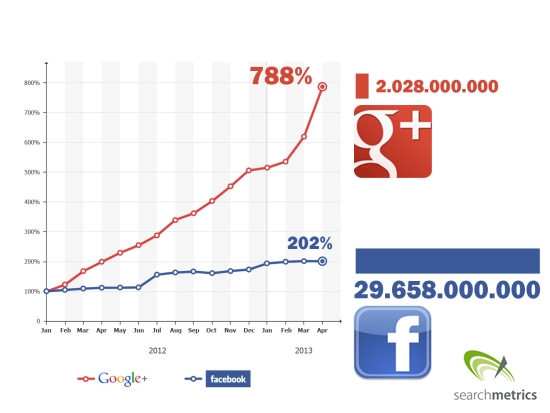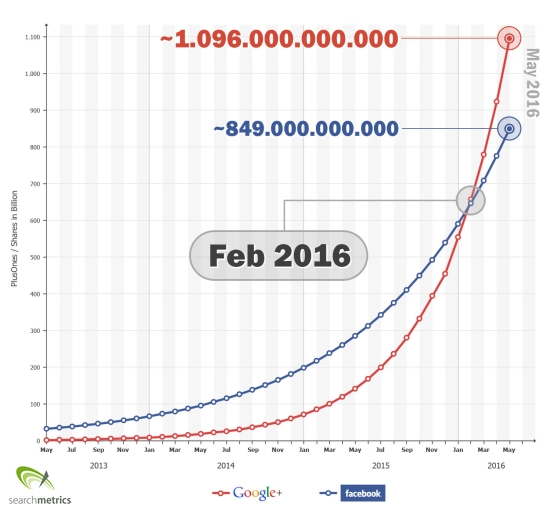Much is written about “social media” these days. Social networks, and in particular the user signals that flow from these platforms into the net, play an increasingly important role in the overall perception. Shares, Likes, Comments, PlusOnes, Tweets and Pins coming from anywhere, promoting recommendations, URLs, images, and content through the Internet – all of which are closely linked to personal user information from the Social Graph.
We here at Searchmetrics are in the wonderful position of being able to measure this data. Our ever growing database and our software, which not only tracks millions of keywords in search engines worldwide, also provides social signals – historical and current – to analyze data more precisely. This puts us in a position to evaluate data on a large, well-founded basis – and to identify relationships between the corresponding factors. Social is just important for Search – and we now have more than 20 trillion global social signals in this large and continuously growing database.
Comparing Social Signals from Google+ and Facebook
We recently carried out an analysis taking social signals from Facebook and Google+ and placing them under the microscope. The basic message: Google+ is growing like crazy, but is in absolute terms still worlds behind Facebook. The fact that Google+ percentage grew much stronger than initially proposed is especially surprising. However, the activity of users on the Google network is much more behind. The social platform of founder Mark Zuckerberg grew more moderately, but is already incredibly large. Concerning both absolute numbers of social signals and the activity of users, Facebook is seemingly indisputably ahead.
The first analysis on Facebook and Google+ has been revised and repeated. In the center of the investigation, the shares as signals from both networks were now measured exclusively. Based on these values, we have calculated the percentage growth of Google+ and Facebook starting from January 2012 to the current period of April 2013. The graph below represents figures for the United States:
Again Google’s network shows a strong percentage of growth – especially the striking increase from February to April. With Facebook however, the curve only rises very slowly. If you look at the absolute numbers to the right you can see why this is.
In the month of April 2013, the absolute number of Shares for Facebook was fifteen times greater than that of Google PlusOnes. The Google network is growing at the stage of small to small which therefore is fast. Facebook is growing from its extremely large base to something larger, and is therefore slower.
The remarkable thing is that Facebook is still growing. And that’s why the blue giant appears to be unquestionably ahead of the market.
Facebook uncatchable?
This statement now becomes questionable, given the current market situation. Now, Google’s network delivers more users through several of their services making it nearly impossible to not use Google’s online services. The question now seems to be no longer “whether” Google+ can overtake Facebook, but rather “when”?
How can Google+ overtake Facebook?
With the support of new services like Google Glasses and the mandatory creation of a Google+ account as part of Android Activation for smartphones, the rise of Google+ accounts will only continue to increase as new services become automatically linked to profiles. Not long ago, Google announced that its Android operating system has over 900 million activations. A large part of it is directly connected to a service and Google+ profile. Last year alone, this meant a growth of over 100% on the basis of 400 million about a year ago.
This interested us and we wanted to know precisely when this would happen. Therefore, we have developed a small growth forecast.
When will Google+ be bigger than Facebook?
First, I want to emphasize that the following calculation – in stark contrast to our other publications – is rather a small glimpse of what the future might be, not a scientific claim. There are many factors that can change how the networks evolve.
Ultimately, growth rates are constantly changing – which in itself is always the variable ratio of the calculation basis related (condition: before and after), i.e. the increasing network size as absolute value, and the growth rate as a percentage size.
Now let’s take a look at the numbers. The basis for the calculation are the percentage growth rates of the two networks of the last 6 months, referring to the rise of social signals or, more precisely, only the shares.
Over this period, Facebook saw a monthly average growth of almost 10 percent, while Google+’s average grew by almost 19 percent per month (again, we refer to U.S. figures). These values form the basis for our forecast. So if this should remain so, we see the development of the two networks for the coming years is as follows:
One thing that is clear in this chart is the incredibly rapid growth of Google+. With a constant percentage growth, Google+ will overtake Facebook in less than 3 years in February 2016.
Google+ grows not only regarding signals but also users at an insane speed. And Google is doing everything to ensure that they well continue! We are aware of the speculative aspect of this calculation. But we ourselves wanted to see what that might look like and share it with you.
Do you think Google+ will overtake Facebook? Let us know in the comments!



